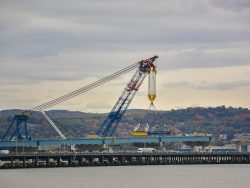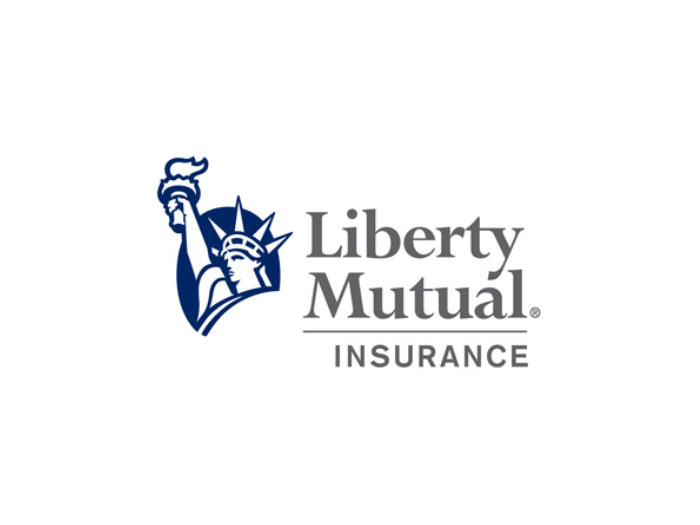15 Things You Must Know About Insuring Mega-Projects: Initial Considerations for the Owner
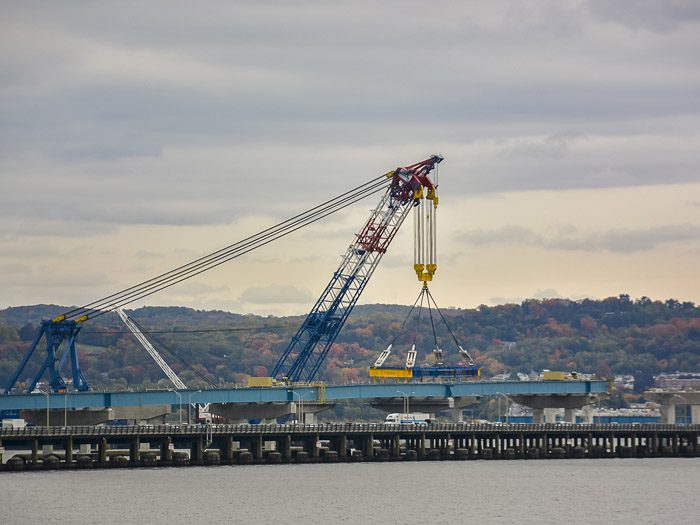
A giant crane lowers new material onto the Mario Cuomo Bridge, which replaced New York’s Tappan Zee Bridge.
Introduction
America has entered the era of the “mega-project.” While the term is notably rather loose in industry definition, it generally refers to projects in excess of $1 billion and encompasses large-scale infrastructure work, such as airports, bridges, tunnels and highway systems, power and rail, to commercial use structures like skyscrapers and hospital complexes.
It is rare these days to drive through or fly into a city whose landscape is not riddled with tower cranes and roadway system reconstruction. Many of these projects engage cutting-edge technology and employ advanced and fact-tracked delivery methods, including public-private partnerships.
Risk on these complex projects is exponentially higher, with a myriad of issues, impacts and damages that can and often do arise in orchestrated, multi-party settings moving at an accelerated pace. Risk management and proper allocation of risk is a paramount theme, not only at time of contract negotiation and formation but also throughout project execution and close-out.
Surprisingly, even in this more sophisticated era of project delivery, a very significant percentage of major infrastructure projects are under-insured, some grossly under-insured or even lacking necessary coverage instruments.
This statement is meant to be provocative, in part. It is also meant to be engaging, to identify for parties on mega-projects, particularly owners, a more comprehensive sense of risk, allocation and coverage.
This subject is especially critical for owners as any risk not covered, not allocated, essentially becomes self-insured. Mega-projects can spawn mega-claims or have major catastrophes. Readers may recall the very recent construction suit in California arising from the I-405 highway project stretching from I-10 in Santa Monica to the 101 freeway, where claims by the contractor on a $721 million project exceeded $500 million and ultimately settled for $297.8 million.
The component of the claims attributable to alleged design and program management error dwarfed available coverage from the owner’s professional team, rendering the owner the insurer of a significant percentage of the risk of loss.
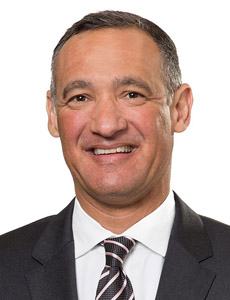
Robert Alfert, partner, co-chair of construction law and litigation group, Nelson Mullins Broad and Cassel
San Francisco’s infamous “leaning tower,” Millennium Tower — which allegedly is continuing to sink — presents a very significant and similar problem, with potentially catastrophic losses and repair costs that could easily exceed all available insurance coverage for the project and the cost of the project itself.
And even more recently, the highly-televised collapse of the elevated pedestrian footbridge at Florida International University — built using “Accelerated Bridge Construction” technique, in which the bridge was constructed prior to installation to minimize traffic interruption — has spawned a multitude of claims, including ones for wrongful death.
While most projects rarely result in that absolute worst case scenario loss, a consideration of all risk events, and developing a comprehensive coverage strategy that balances risk of loss with the availability and cost of insurance products, is a primary issue for evaluation and development at the early planning and contracting stages.
Our focus is on the strategy for insuring these mega-projects and available coverage products for large-scale infrastructure projects. A separate article could be devoted to related contractual provisions, which must be coordinated with the entire risk management strategy of the project, including insurance, so that no conflicts or gaps in coverage, or inadvertent limitations in coverage, are set by standard construction contract provisions, for example, the AIA General Conditions mutual waiver of consequential damages.
Our predominant focus will be on the core insurance instruments: builder’s risk, commercial general liability (CGL) and professional liability; underscored by a related discussion of performance bonds.
The ultimate intent is to provide owners with an executive-level summary of insurance and bond instruments that are necessary to provide mega-projects with customized, appropriate coverage against risk. Our discussion will begin with a comparative analysis of two ongoing mega-projects at Orlando International Airport and Los Angeles World Airports, both of which developed customized solutions to address the significant risk at both multi-billion dollar projects.
With that in mind, here are 15 things you should know about risk and insurance, from case studies to lines of insurance to bonds and securities, before taking on a project of this magnitude.
1) Developing an insurance coverage matrix is an early planning activity.
This discussion goes hand-in-hand with the predicate analysis regarding which delivery method is appropriate for the project, how risk will be allocated and managed, and how all of the project stakeholders will be selected.
The insurance coverage strategy, and what risks are covered and to what degree, can turn on whether the owner uses a traditional design-bid-build approach, design-build, construction management (at-risk or at-agency), or a more progressive public-private partnership; and as often as the case, these mega-projects can involve several projects under different delivery methodologies and contracting parties.
The insurance strategy and coverage instruments must account for these various approaches.
Risk on these complex projects is exponentially higher, with a myriad of issues, impacts and damages that can and often do arise in orchestrated, multi-party settings moving at an accelerated pace. Risk management and proper allocation of risk is a paramount theme, not only at time of contract negotiation and formation but also throughout project execution and close-out.
2) Selection of prime design professionals and construction entities should include, from the outset, the ability to procure coverage instruments in threshold limits that are suitable to the project.
Many architectural and engineering firms have difficulty procuring professional liability policies with thresholds in excess of $25 million.While large-scale infrastructure contractors generally have CCIPs or CGLs in the $100 to $200+ million range, not all contractors have the capacity to procure surety bonds at the mega-project value, which is the threshold that some states require.
These considerations should be at the forefront of any competitive procurement required for public entity owners and at the early contract negotiation stages for both public and private owners.
Additional considerations include:
- Full assessment of risks (public, property and business)
- Delivery methodologies
- Types of losses, ranges and worst-case scenarios
- Contract instruments and how risk is allocated
- Risk tolerance and self-insured risks
- Cost/budget
- Requirements of funding instruments
- Schedule, fast-tracking and attendant risk
Consideration of these and other factors will assist the owner in creating a template for the proposed insurance coverage matrix for the project as a whole.
The marketplace and further negotiations with the contracting parties can assist in better refining and customizing a coverage matrix that achieves the optimal balance of risk management versus cost control. Of course, not all risk can be averted and not all risk is insured, but the customized solution should be a thought-out process, not a solution backed into by default.
3) Case Study: Orlando International Airport — South Terminal C Expansion
Orlando International Airport (OIA) has embarked on an ambitious capital improvement program totaling approximately $4 billion, with improvements to the existing terminal, design and construction of a new international terminal and associated facilities, and an intermodal terminal facility for the incorporation of multiple rail lines.
The first phase of the program, commencing in 2012, was approximately $750 million in the necessary infrastructure to stage the new terminal, including an automated people mover (APM) system and terminal connecting the existing terminal to the planned new terminal, a 3500-car parking deck and the Intermodal station for rail.
This phase was carried on with three major contracts: Two for the construction management at risk delivery of the APM terminal and parking deck and then the intermodal station, and a separate contract for the design-build-finance-operate-maintain (DBFOM) of the APM system itself.
The second phase of the program entails the construction of a 16-gate international terminal connected to the APM and Intermodal terminals. This approximately $2.1 billion project is also being carried out with two additional construction management at risk contracts and then a separate DBOM for an approximately $200 million innovative baggage handling system contract.
Given the increasing traffic data and projections, in 2018, approximately $700 million in scope was added to the program, primarily for the addition of nine more gates and all associated facilities.
The overall program is managed by separate contracts for the general consultant, architect of record and program management entity.
Timely delivery was imperative in light of requirements to funding and grant instruments and third-party commitments to Brightline high-speed rail, airlines and other concessionaires. The dollar value of the program — now nearly $3 billion (excluding rail) — and the consequences of delay or costs of defects and damages created risk scenarios that far exceeded traditional insurance and bond coverage thresholds.
The entire insurance program, owner-provided and vendor-provided, in addition to bonds, guarantees and subcontractor default policies, were all highly coordinated to create a broad matrix of coverage to maximize protection and minimize risk.
The additional cost of some overlapping limits of insurance and policies, and higher limits than industry norms, was a sound business hedge to offset risk to this very complex and critical program.
4) Case Study: Los Angeles International Airport — Landside Access Modernization Program
Los Angeles World Airports (LAWA) currently has a $14 billion Capital Improvement Program at Los Angeles International Airport, one of the largest public works projects in California history, and is set to be complete in 2023.
This Capital Improvement Program includes a $1.6 billion concourse project that adds additional gates and a corresponding Baggage Optimization Project; a $515.8 million renovation to its Terminal 1; and most notably, a multi-billion dollar Landside Access Modernization Program (LAMP).
LAWA’s LAMP includes several major program elements: A 2.25-mile APM that connects on-airport stations to Metro Rail and transit services that acts as the centerpiece of LAMP, with an estimated cost of $4.9 billion; a consolidated Rent-A-Car center that recently reached financial close and has an estimated cost of approximately $2 billion; Intermodal Transportation Facilities; and roadway improvements.
Like many transportation programs, the critical risks of LAMP, including safety and security, necessitated assurances of timely completion, indemnity and coverage for third-party delay or late delivery claims and a world-class design and construction delivery free of defect.
To manage this risk, the Board of Airport Commissioners awarded a P3 Developer a 30-year contract valued at approximately $4.9 billion to design, build, finance, operate and maintain the APM. The financing structure includes approximately $1.3 billion in private activity bonds, $270 million in bank debt and private partner equity.
In managing these risks, the LAMP APM developer was required to obtain and maintain insurance for different stages of the project that are tailored to the risks involved. The complexity associated with such a large program dictated a customized approach to managing and insuring risk, understanding that any damages above insurance limits are potentially self-insured.
As with OIA, traditional insurance methodologies would not suffice.
To address the escalated risk associated with these ever-increasing large scale projects, Parts 2 and 3 of this article delve deeper into the risk-mitigating resources available to owners and contractors. &
Part One: Initial Consideration for Owners
The U.S. has entered the era of the mega-project. Insurance must respond accordingly.
Part Two: The Core Insurance Instruments
A deeper dive into the insurance products available for construction mega-projects.
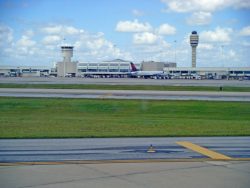 Part Three: Performance Bonds and Alternative Security
Part Three: Performance Bonds and Alternative Security
Promoting a more customized approach to risk management on mega-projects.


